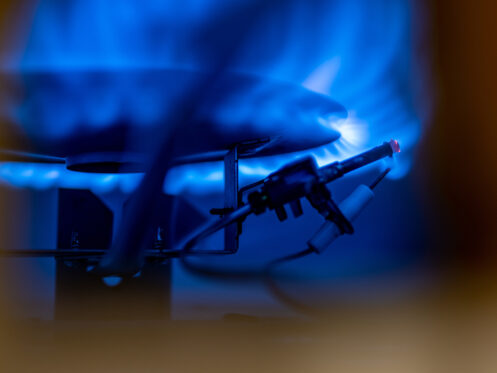A pilot light is a small but important part of your gas-powered appliance systems. Water heaters, furnaces, and other equipment use pilot lights for safe and on-demand ignition. Understanding what a pilot light is and how this little blue flame works is key to maintaining your home’s systems.
Whether you’re troubleshooting your water heater or furnace, High 5 is ready to assist residents in the Greater Denver Metro area with services built on honesty, efficiency, and affordability.
What Does a Pilot Light Do?
A pilot light is a continuously burning blue flame in a gas-powered appliance, such as a furnace or water heater. The pilot light provides an ignition source for gas appliances, allowing them to ignite the main burner automatically whenever a heating cycle initiates. A steady pilot light prevents heating failures or delays and indicates the proper function of the appliance’s combustion and ventilation systems.
The pilot light remains lit by drawing a small amount of gas through the pilot tube. When the appliance turns on to start heating, its control system opens the main gas valve to release gas to the burner. The pilot flame, located near the valve and burner, immediately ignites this gas to begin the heating cycle.
Types of Pilot Lights
Gas appliances use varying ignition systems that work in different ways.
Standing pilot light
Standing or continuous pilot lights are commonly found in older gas appliances. This pilot light requires a continuous gas supply to remain lit and provides immediate ignition as needed.
While reliable, continuous pilot light heating systems are less efficient than other types and typically achieve between 56% and 79% annual fuel utilization efficiency (AFUE) ratings. Water heaters typically achieve between 0.63 and 0.95 uniform efficiency factor (UEF) ratings, with standing pilot lights representing the lower end.
Intermittent pilot light
Many modern furnaces eliminate the need for continuous pilot lights by using electronic ignition systems, such as intermittent pilot lights. When the appliance control board initiates a heating cycle, the ignition system opens the gas valve and creates a spark to ignite the burner. This design improves fuel efficiency and reduces unnecessary fuel consumption. These systems commonly earn between 80% and 98.5% AFUE.
Hot surface ignition
Hot surface ignition systems use a heat-conductive and fork-shaped element made from silicon carbide or silicon nitride to ignite gas burners. When the appliance signals a heating cycle, high-current electricity runs through and heats the igniter to 2,500 degrees. After a few seconds, the gas valve opens to allow gas to flow and light the burners.
Background of Pilot Lights
Previously, gas-powered appliances required manual ignition when households needed hot water or heat. Pilot lights enabled automatic ignition and on-demand heating for gas-powered furnaces, water heaters, and fireplaces, enhancing household convenience and safety. Technology has advanced to adopt different kinds of ignition systems, but many households still have appliances with pilot lights.
Importance of Pilot Lights
Pilot lights serve several important functions in gas-powered appliances.
Safety features
Pilot lights work with other components in your gas appliances to ensure safe operation. Most systems use a thermocouple, a small sensor made from metal that detects the flame and controls the gas supply. When the pilot flame heats the thermocouple, it generates a voltage that keeps the gas valve open.
If the flame goes out or provides inconsistent heat and the thermocouple’s temperature drops below a certain level, the voltage likewise drops and cues the valve to shut off. This mechanism blocks gas flow from accumulating in the appliance, which can cause:
- Gas leaks
- Explosions
- Fires
- Carbon monoxide leaks
The pilot light can also serve as a warning signal of underlying appliance malfunctions. If it becomes yellow, flickers, or goes out repeatedly, your system may have debris buildup, a faulty thermocouple, venting issues, or other problems that impact your system’s safety or performance.
Energy efficiency
A conventional pilot light burns continuously and consumes gas even when the appliance is on standby. Gas appliance systems have complex operations with components working together to maintain optimal energy efficiency.
A properly functioning pilot light is part of this precise system. A steady blue flame indicates a consistent and well-balanced fuel supply. This balance of gas and oxygen optimizes combustion and prevents the system from producing excessive carbon monoxide or soot.
Clean combustion improves fuel efficiency because the furnace or water heater doesn’t have to work as hard to generate heat. It also minimizes wear on your system, which reduces inefficiencies related to damaged or dirty components.
Maintenance and Care
Consistent maintenance helps keep your pilot light in good condition and optimizes your appliance’s performance. Regular tune-ups come with these advantages:
- Enhanced comfort: A clean, reliable pilot light allows your water heater or furnace to heat without delays or failures.
- Improved safety: Regular maintenance identifies and addresses worn or faulty components that support safe ignition and ventilation.
- Lower energy costs: Optimal combustion and fuel utilization reduce energy bills over time.
- Prolonged appliance lifespan: Soot buildup and faulty components can strain and damage your system, resulting in premature failure and replacement.
Regular furnace or water heater inspections and maintenance services effectively protect your system from premature wear, failure, or other problems. During tune-ups, your technician inspects your system closely to detect wear or inefficiencies. They’ll also complete maintenance tasks, such as cleaning the pilot light orifice and burner, and recommend necessary follow-up actions to keep your system running optimally.
Trouble With a Water Heater Pilot Light? Contact the Plumbing Team at High 5
If your water heater pilot light isn’t working as it should, our plumbing team at High 5 is ready to help. High 5 offers comprehensive plumbing services that focus on what’s needed and the most effective way to do the job. True to our core values, our plumbing company provides upfront and affordable pricing. We work hard to earn our customers’ trust and satisfaction! Contact us to schedule a service with our expert team.

